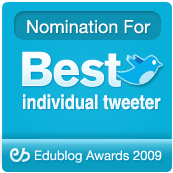(Photo used under Creative Commons license)
For the Evolution of Cooperation class on I'm currently taking with Howard Rheingold, our assignment this week was to write a response to the following question (which was proposed by one of the co-learners and selected by Howard):
How can we apply the concepts from the work of Axelrod and the others to the operation of an ordinary workgroup? Like a university department, a unit in a business, or maybe a local social club? In particular, how do we use new technologies for this purpose?
(Robert Axelrod's seminal "Three Conditions for Human Cooperation" is summarized here (.pdf).
“Once the word gets out that reciprocity works – among nations or among individuals - it becomes the thing to do.” Robert Axelrod
If the group shares common outcome goals, do the members also share some agreement about process, i.e. about how best to reach those goals? Should acknowledgment or rewards be moved away from individual efforts and towards instances of collaboration and cooperation? If one of the process goals of a group is increased cooperation, storytelling can play a vital role in helping to reinforce a shared sense of purpose. Stories of times when cooperation worked can be held up as positive examples. And moves which run counter to a stated goal of increased cooperation can both be acknowledged and framed within a context of forgiveness and re-dedication to the goal.
In addition to looking critically at the rewards structures and shared understandings within a group, members could also benefit from an analysis of the effects of their schedule and physical environment on their work together. How does a work day that runs from 9am to 5pm map onto individual workers’ biological rhythms? What are the affordances of a work space in which everyone works behind a closed door? Open work spaces can amplify the possibilities for collaboration by reducing barriers between people. They can also be distracting. (ref. David Korfhage)
Finally, what about all these screens to which we give more and more of our attention; can they simultaneously be drawing us both away from each other and towards each other? How do the technologies we use or resist enable, empower, and/or undermine cooperation? Could encouraging members to post questions and answers in a school- or company-wide forum help break down disciplinary “silos”? Might having a group leader who blogs about her failures open up a space for her team members to take more risks? Will the increasingly “on demand” availability of answers to content-based questions move us all beyond thinking of informationalhoarding as a legitimate strategy for gaining advantage? As we witness wide-scale collaborative endeavors take hold across a multitude of disciplines, will an increasing awareness of cooperative options result in an increased sense that “reciprocity works”? Or will we all just amuse ourselves, if not to death, then at least into ever cozier and tighter filter bubbles, like hermit crabs in reverse?
Who is creating new patterns of action? Which of these will be transparently shared? And of those shared, which will fall on fertile soil and take root?
(More questions than answers...
the usual!)








No comments:
Post a Comment